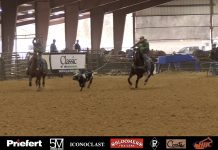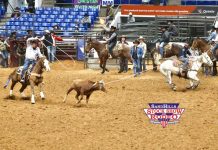Breaking it Down by Speed Williams – July 2024
There are many different ways to coach and give lessons and I have witnessed most of them. From the age of 12 or 13, when we lived in Florida, I had a lot of success heeling. My dad sold a lot of horses and we always had people at our place trying horses. People came from all over the east coast who had never ridden or roped but wanted to. It was my job to teach them to catch, stay on, and follow the cow.
That has evolved, especially after winning IPRA championships on both ends and ultimately winning eight PRCA championships heading. In the beginning of my teaching as a professional, I was guilty of giving people too many things to work on at one time. I have learned to keep it to just a couple of things and build on those.
It’s usually different with younger people, especially teenage boys. A lot of times they want to do it their way. I will give them things to work on, whether it’s running close or reaching. But I’ve learned if you let them work at something and struggle for a couple of hours, they are usually more willing to listen and get help. We do a lot of drills which may not be the most fun, but it’s crucial to getting better and expanding their ability. We move the Speed Trainer in various positions making it easier to find the weaknesses we need to work on.
Everyone doesn’t learn the same. In my lessons I’ve incorporated the way Rich and I roped. We would film our practice in the morning and then watch the video and break it down. After lunch we would do the same thing. In my schools I give scenarios the students have to execute because it’s important to simulate real life situations. You have to practice getting out on a specific start and make the run in the time you need to win. It’s situational practicing. For instance, if you’re fifth high you need to gamble a little and try and go faster. But high call with a big lead where you have to be 11-seconds to win is different. That’s something people didn’t practice for a long time.
In my schools I don’t yell much, except when students do good. When they don’t, we’re going to watch the video and talk about what happened. My kids can tell you I have never yelled or scolded them when they’ve done poorly. I’m a firm believer when you don’t do well you have a 10-to-15-minute window to gain composure and process what happened. We will watch the video to understand what happened and try to eliminate those mistakes in the future.
I am guilty of not giving my kids much information in the practice pen for a couple of reasons. One: I want them to sit and watch the video and break it down with me so in the future they know what happened. Two: I want them to try and figure it out themselves if they’re doing something wrong. If they struggle with it long enough, it doesn’t become a problem in the future. How to eliminate the problem will be instilled in their mind.
There are many different fundamental ways to accomplish the same goal when roping, whether it’s heading, heeling, or roping calves. I’m a math guy and I always try to eliminate wasted motion in a run. I do this by watching runs on video, frame by frame, to understand how to eliminate steps or movements.
What’s new with us:
Gabe turns 18 in October, and for the last year we’ve been talking about his heading. Finding a rodeo partner you’re compatible with is very tricky. I told him if I can teach him to head correctly and eventually head at an elite level, he could control his future. As a heeler you’re always dependent on the header keeping his horses working and have the money to buy good head horses. The problem is there are 100 heelers to compete with over that header. If you’re able to head correctly, it’s much easier to find someone you can make a living with. Will we accomplish this? Only time will tell.
Father’s Day weekend we went to the World Series in Athens, TX, where he headed for me in the Open, #15, and #14. Usually, this time year most of the big guns are on the rodeo trail, but there were enough there to make the roping pretty tough. Driggers was first and second call back. Gabe and I were 5th call back at his first Open roping. I roped two feet and my dally popped off the horn. Wesley Thorp rode by and said, “That mare’s not hard to dally on, I’ve ridden her.” He was joking with me because he knows how much she slides.
Then we head to our hometown rodeo in Comanche with 70 or 80 teams. Gabe did a good job, and we were 4.8 plus a leg. It’s going to be a lot of fun and exciting to see how far he can take his heading. He’s heeling outstanding right now and no matter which end he chooses; heading will help him understand his heeling better.
For the last month or so Hali has been getting where she can practice again. About three weeks ago she tweaked her ankle coming across the line. She’s been in some pain but still practicing. Just like before the Breakaway finals, I stressed to her she needs to heal up more than she needs the practice since she will be leaving for the summer. It’s more important for her to be healthy than to run 20 or 30 a day.
Both kids still do a lot of drills on the Speed Trainer where I can isolate the little things we need to work on. I like to simulate the angles as close to realty as possible and create the situations where they struggle. Understanding how to get better is preparing for the steer or calf that will take you out. You’re only as strong as you’re weakest link. Always, always work on your weakness.




